What Is Userlane Used For: Top Features and Use Cases

Curious about how you can use Userlane to grow your product? What are its best features and are there any drawbacks you should be aware of before investing in it?
We answer these questions in this article and dive deep into the use cases and features that Userlane offers, its pros and cons, along with its pricing. We also explore an alternative tool that might interest you.
Let’s dive in.
TL;DR
- Userlane is a digital adoption platform used by SaaS companies in a number of ways, primarily for product adoption, product analytics, and user feedback.
- Some impressive functionalities offered by this tool to help you achieve your goals include user onboarding, in-app support, funnels, event tracking, in-app surveys, and survey analytics.
- While Userlane is a promising solution, there are better alternative tools in the market. One such tool is Userpilot, which offers greater value for money and a diverse feature set, spanning from product adoption to customer feedback to user behavior analysis and beyond.
- If you want to see how Userpilot can help your SaaS company grow, book a demo today.
![]()
There is a better tool for your SaaS than Userlane!

What is Userlane?
Userlane is a no-code digital adoption platform used to measure how employees use applications, identify areas for improvement, and offer real-time guidance directly within any application.
In addition, it allows you to get a real-time view of digital transformation progress in your organization. You can now delve deeper into user behaviors across different applications and analyze engagement levels so you can optimize user experiences.
What is Userlane used for?
Userlane can be used in multiple ways to grow your company, but we’ll be going into detail regarding the below use cases and their respective features:
- Product adoption
- Product analytics
- User feedback
Userlane’s main use case: product adoption
Product adoption occurs when users discover, try out, and get hooked on your product. Every business goal depends on how well users adopt your product.

Ways Userlane helps teams increase product adoption:
- It layers on other software applications to provide employees with step-by-step on-screen support.
- It actively manages software applications and prevents procedural errors.
- It helps employees reach their goals by tracking their intent and recommending actions.
Userlane’s functionality for product adoption: user onboarding
Teams use Userlane to ditch the stress of manual onboarding. The platform allows you to build a customized and interactive onboarding dashboard for each software, promoting an easy software onboarding experience every time.
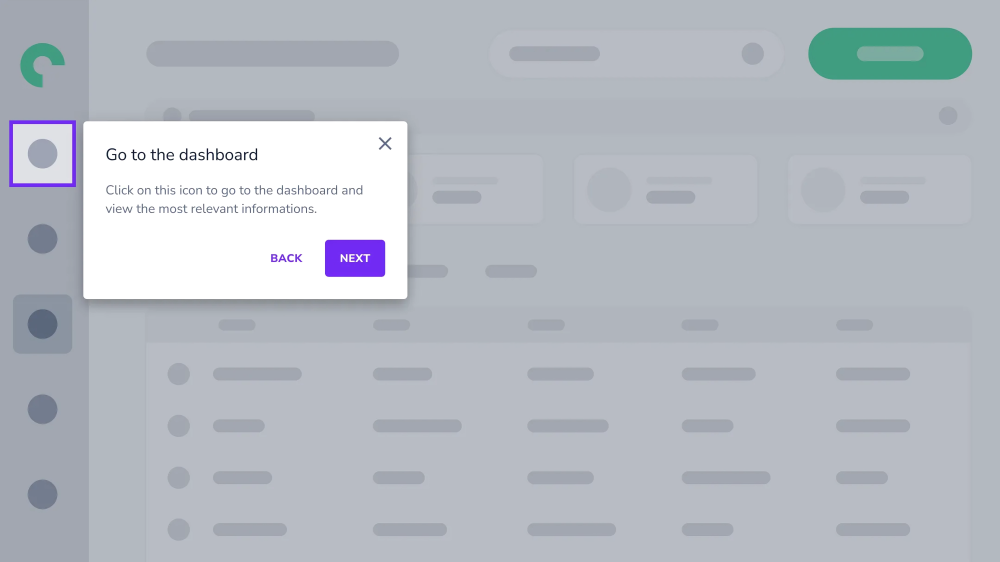
Here are some ways Userlane helps with onboarding:
- Digital adoption solution: Userlane has a digital adoption solution that provides on-screen, step-by-step guidance to your users. This way, users can navigate your software with ease. You can also create an interactive in-app guide that walks users through tasks, so there’s no steep learning curve or need for external training materials.
- User-specific communication: User onboarding isn’t one-size-fits-all. Everyone’s needs are different. You can customize and improve their walkthroughs and communication based on the user’s behavior and software. Personalized communication makes it easy to remember how to use the features and get help.
- Comprehensive Analytics: Userlane has two applications for user analytics: HEART and Content analytics. HEART is Userlane’s premiere model to monitor software adoption across enterprise apps. The model shows if an application delivers the expected value. And highlights areas teams can improve and optimize. Content Analytics adds a layer of interactivity for guided learning within the platform. This feature allows teams to create guides, tips, and Pop-Ups and host NPS surveys.
Userlane’s functionality for product adoption: in-app support
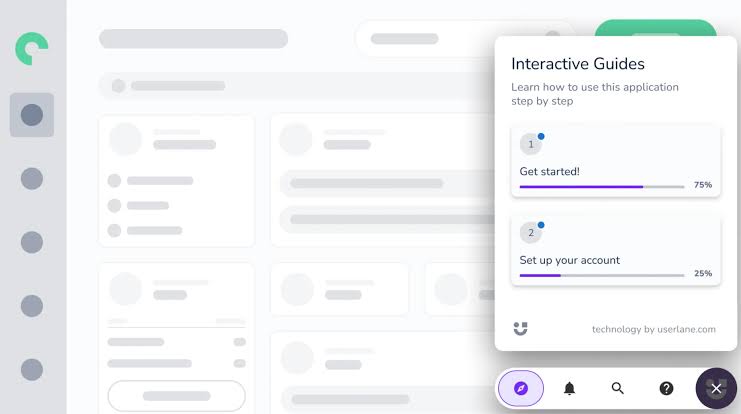
Two ways Userlane provides in-app support to users are:
- Userlane Assistant: Userlane Assistant is Userlane’s main navigation tool. It helps users access content, guides, and announcements.
- Userlane onscreen guides: Userlane guides walk users through product features in real time. This way, users can advance at their own pace while they continue their tasks within the software application. You can also pause and resume each interactive user guide at your convenience. An awesome feature of the guide is the flexibility. Businesses can customize guides and target them toward specific audiences. This ensures that the right information gets to the right people at the right time.
![]()
Looking for the best tool for product adoption? Search no more!

Userlane’s main use case: product analytics
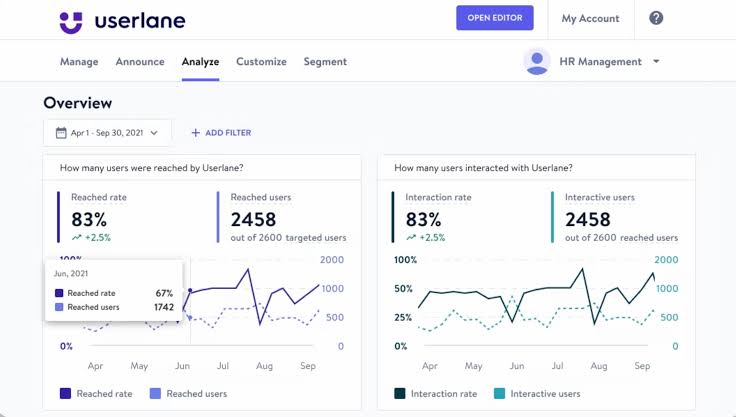
Teams perform product analytics to track the performance of the software they build.
While Userlane excels at employee onboarding and digital adoption, it doesn’t serve as a product analytics tool.
Userlane users can access surveys to identify and address software-related issues, ultimately improving performance.
For comprehensive product analytics, consider UserGuiding or Userpilot.
Userlane’s functionality for product analytics: funnels
While Userlane is not specifically designed for user funnel tracking, you can potentially use it to guide users through specific steps in your user funnel and gather data on their interactions and progress.
However, for more comprehensive funnel tracking and analytics, you might want to consider dedicated tools like Userpilot, as well as Google Analytics, Mixpanel, or similar platforms that offer in-depth insights into user behavior at different stages of the funnel.
Userlane’s functionality for product analytics: event tracking
Event tracking is vital for understanding how users interact with your digital products. Tracking user interactions, from button clicks to form submissions, provides data to inform UI improvements and feature development.
![]()
Userlane’s analytics privacy settings enable you to select the level of event tracking that you need to help you understand how well your applications are being adopted. Here’s an overview of the functionality of Userlane as it relates to event tracking:
- HEART Analytics: HEART is a user-centered metrics framework. Google developed it to evaluate the quality of the user experience. You can enable HEART to understand how users interact with your applications (e.g., click events, viewed pages, time spent).
- Basic anonymous event tracking: If you do not want HEART analytics, Userlane’s Basic anonymous event tracking captures your user’s interactions with Userlane, such as guides started, assistants opened, or announcements viewed.
- Advanced tracking: Advanced tracking captures interactions in your underlying applications including clicks, URL changes, and URL views.
Userlane’s main use case: user feedback

Userlane enables teams to collect user feedback and enhance product experiences through basic survey functionality. While their primary focus is on interactions, you can also gather feedback.
However, it might be challenging to track and analyze the data since it is not their core use case.
You might want to consider alternatives like Userpilot and Walkme for collecting user feedback.
Userlane’s functionality for user feedback: in-app surveys
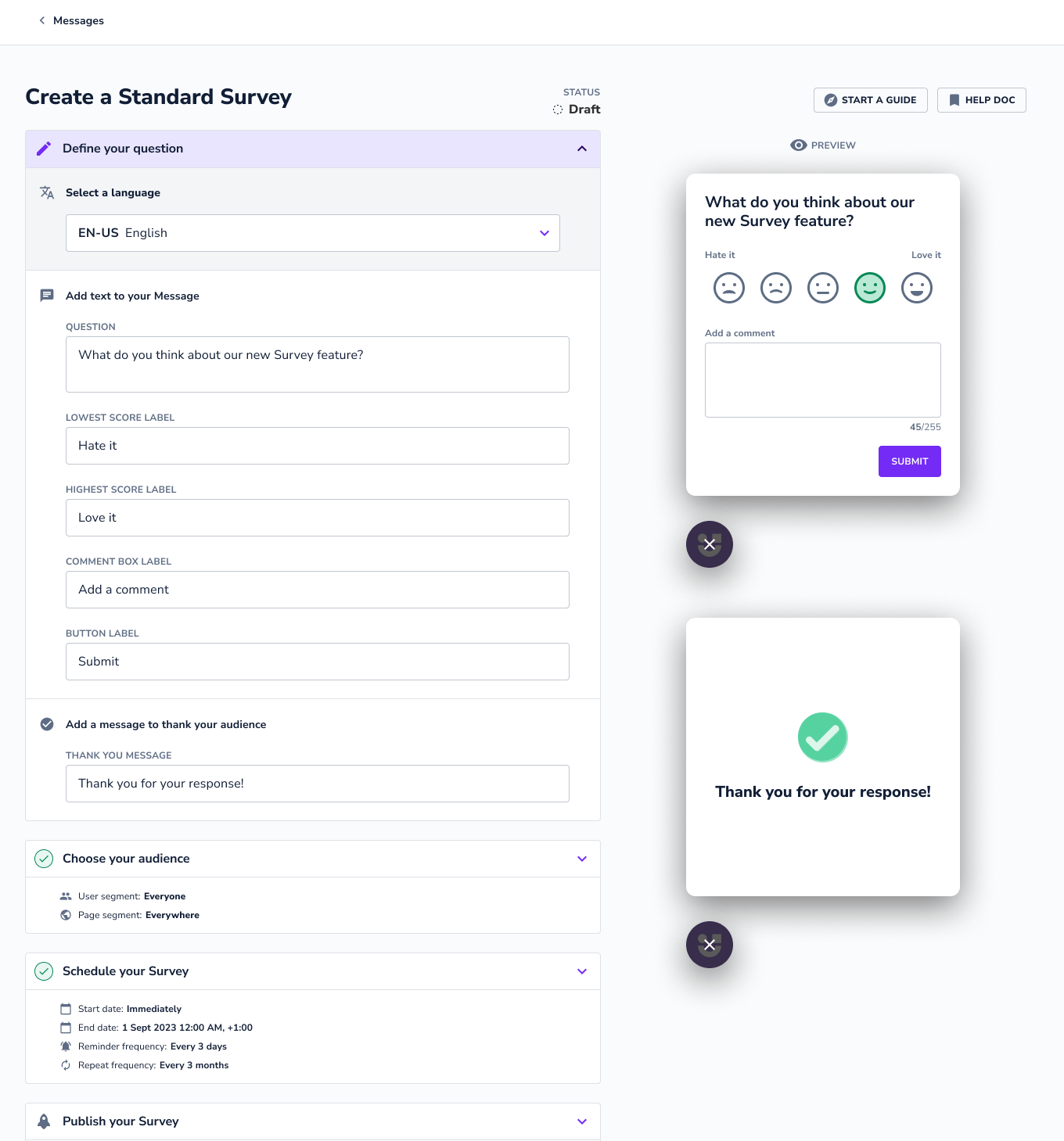
Product teams use in-app surveys to conduct user research, personalize user experience, assess satisfaction levels, measure customer loyalty, identify new feature ideas, and better understand user behavior.
- With the new emoji-based scale, survey participants can easily provide feedback by selecting one of five emojis representing different sentiments. The leftmost emoji corresponds to the lowest rating and the rightmost to the highest. This user-friendly, easy-to-use system allows quick responses, encouraging engagement and a high participation rate.
- You can translate the survey into other languages by switching the language.
- You can decide who should participate in the survey by setting up a dedicated user segment. Select a page segment to display it on specific pages only. You can also specify the activation date of the survey and how often you want to send reminders to users who haven’t responded to it yet.
There are other comprehensive features that Userlane does not possess, for example, with Userpilot’s heatmaps and event analytics you can gain insights into users’ behavior compared to Userlane. This could reveal that some users don’t engage with the right features for their use cases, which translates into poor survey results.
Userlane’s functionality for user feedback: survey analytics
Userlane’s survey analytics allows users to measure satisfaction by asking questions about the application and its features, which is vital in tracking digital adoption progress.
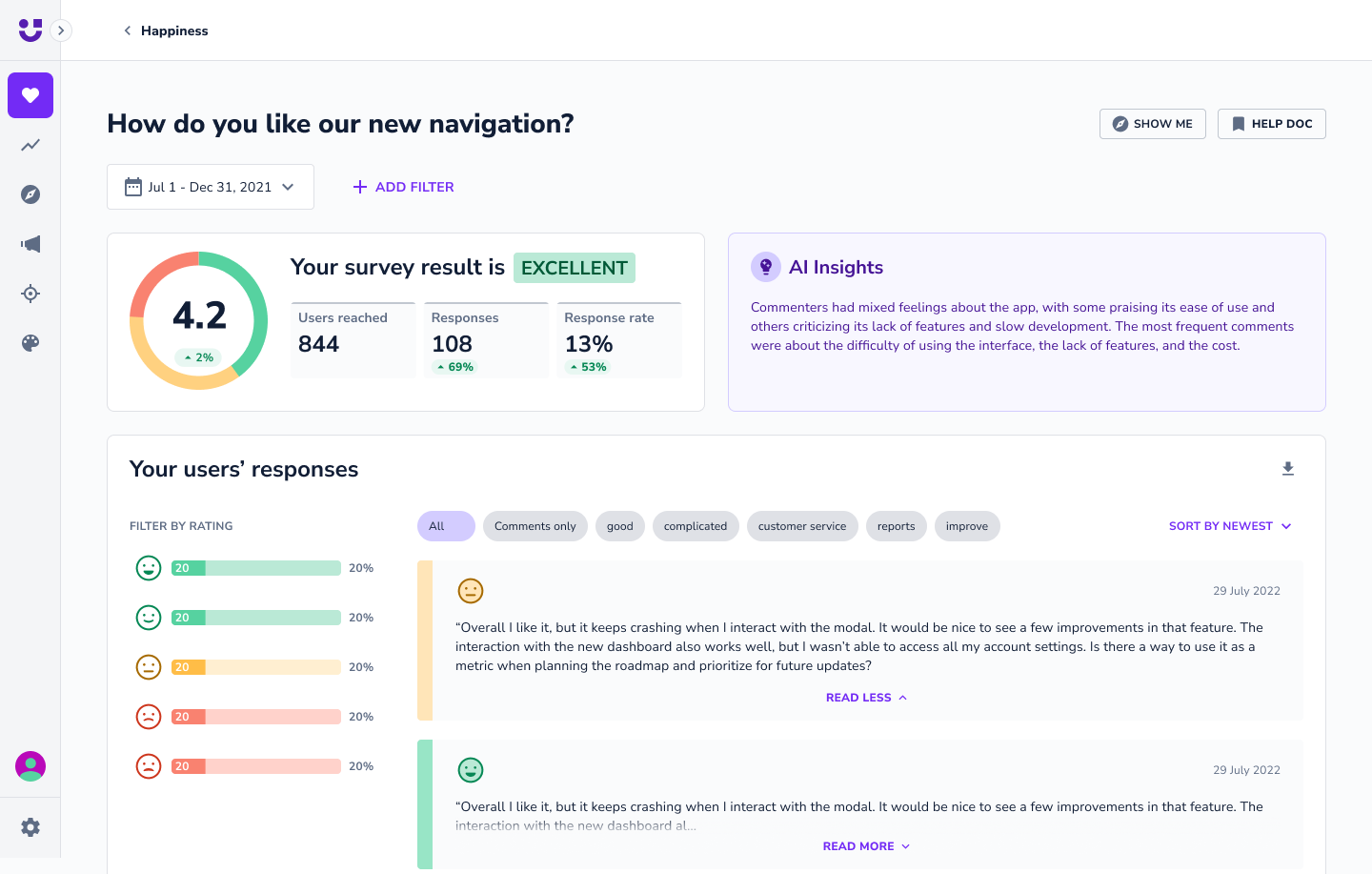
Here are some features of Userlane that can help you get better survey analytics results:
- The platform employs an emoji-based scale, facilitating easy feedback provision from participants through five distinct sentiment-representing emojis. Multiple surveys can run concurrently across different application pages and user segments.
- Each survey possesses its own analytics page, where responses and user comments can be monitored. Date and segment filters are available to narrow down results for specific periods or user groups.
How much does Userlane cost?
Userlane’s pricing plan is structured in a customizable pattern. This means you need to get a custom quote to know the plan that fits your brand’s purpose based on the level of your SaaS and the number of acquired customers.
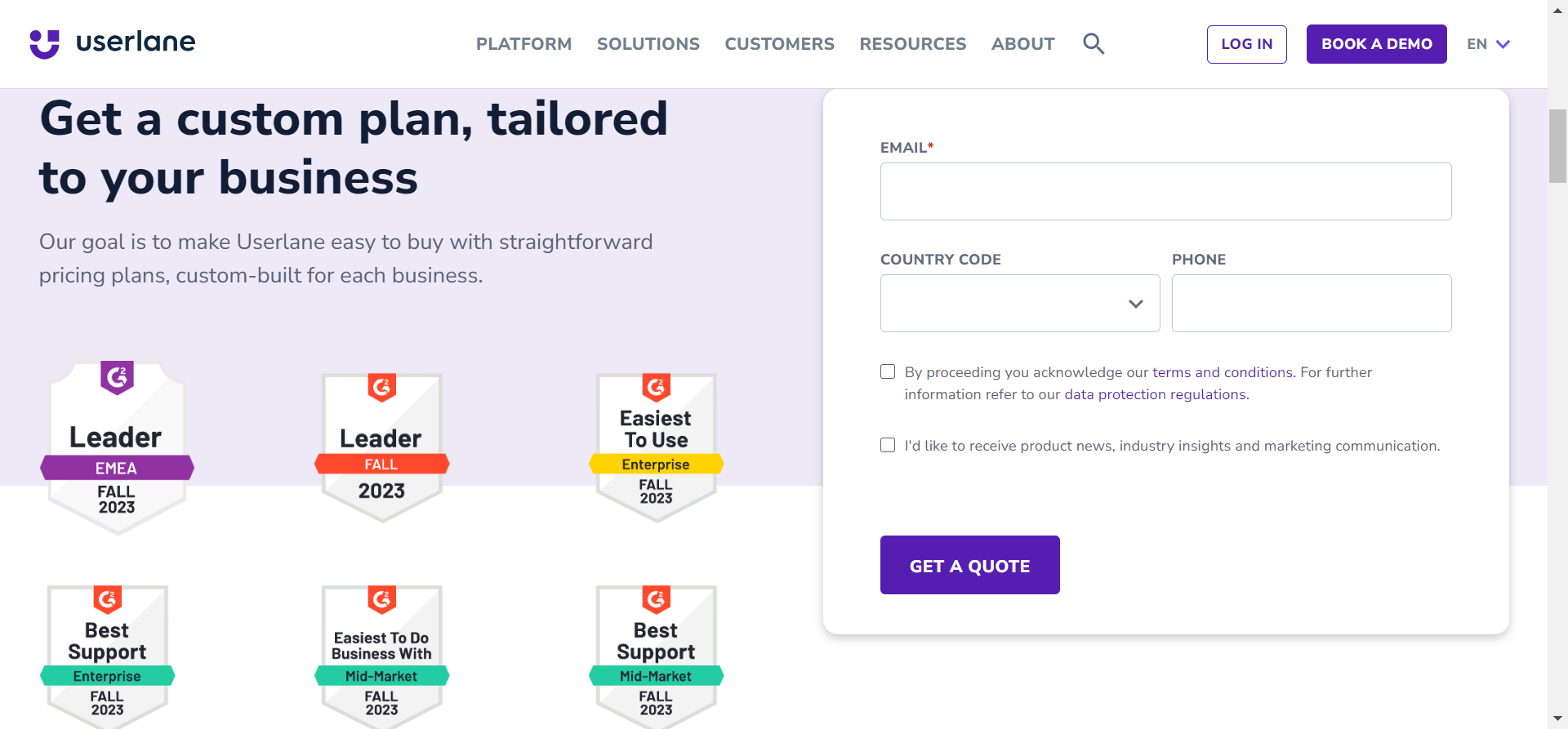
Benefits of using Userlane
Higher productivity, less support effort, and happier users are what Userlane is created for. From a vast spectrum of capabilities to elegantly crafted UI elements that cater to any walkthrough, regardless of its level of customization, Userlane stands out as a robust platform to bolster user engagement and product familiarization.
Let’s dive into the pros of using Userlane:
- Streamlined no-code interface: Userlane boasts a user-friendly dashboard, enabling even those with no coding background to easily design and implement onboarding flows.
- Product adoption analytics: Get a real-time view of digital transformation progress in your organization. Delve deeper into user behaviors across different applications and analyze engagement levels so you can optimize user experiences.
- Dynamic user walkthroughs: Craft compelling and interactive walkthroughs that intuitively guide users through your software, ensuring they grasp every essential feature.
- Versatile in-app communication tools: Whether tooltips, banners, or pop-up modals, Userlane offers many tools to engage users directly within your platform. With Userlane’s customer onboarding solution, you can tailor communications for different user segments, guiding them through the tasks and processes they will most likely need help with.
- Seamless third-party integrations: Integrate Userlane with various analytics tools, CRM platforms, and other essential software to ensure a harmonious workflow and data sharing.
- Granular audience segmentation: Understand your users and their needs better by segmenting them based on behavior, user type, or other customizable metrics. This ensures that your messaging and tours are always relevant and timely.
- Optimized A/B testing capabilities: Refine your onboarding and in-app messaging by A/B testing different approaches, enabling you to continually enhance user experience based on concrete data.
- Thoughtful pacing with walkthrough rate limiting: Ensure users aren’t too quickly bombarded with too much information. With Userlane’s rate limiting, you can pace the introduction of new features or tasks, striking a balance between informing and overwhelming.
Drawbacks of using Userlane
As with any tool, weighing its strengths and weaknesses is essential. Here are the notable drawbacks of adopting Userlane:
- Visual Customization Restrictions: One of Userlane’s apparent setbacks lies in its restricted visual customization capabilities. If you have an eye for aesthetic and unique branding elements might find the platform limiting. The lack of diverse templates and somewhat rigid design elements could impede brands from truly reflecting their identity.
- Analytical Ambiguities: In the age of data-driven decision-making, Userlane’s analytical powers — or the lack thereof — stand out. While it offers basic insights, those looking for a deep dive into granular user behavior, funnel analysis, heatmaps, and more might need to bridge the gap with external integrations.
- Integration Quandaries: Speaking of integrations, Userlane might not be the Swiss Army knife of connectivity that some businesses might be hoping for. While essentials like Zendesk, Google Analytics, Hubspot, and Salesforce are on the list, those yearning for a wider array of integration options might need to strategize around these limitations.
- Cost Considerations: Userlane’s pricing structure could be a roadblock, especially for startups and SMEs keen on budget constraints. The initial investment for Userlane might seem daunting, especially considering the added costs of potential integrations and the learning curve associated with maximizing the platform’s potential.
![]()
There is a better tool for your SaaS than Userlane!

Why an alternative is needed for Userlane?
While Userlane is undoubtedly powerful, certain scenarios might necessitate exploring alternatives.
- Extensive Third-party Integrations: While Userlane offers some key integrations if your business heavily relies on a diverse range of third-party tools and you need a seamless, in-depth integration for all of them, you might want to explore platforms like Pendo or Mixpanel that offer broader integration ecosystems.
- Budget Constraints: While Userlane offers a plethora of features suitable for established enterprises or growing companies, it might be beyond the reach of early-stage startups with limited funds. If you’re on a strict budget and looking for a more affordable solution, platforms like UserGuiding, Intercom, or Intro.js might be more aligned with your financial constraints.
- Complex Customization Needs: If your platform requires highly specialized or intricate onboarding experiences that go beyond standard walkthroughs and tooltips, you might find Userlane’s customization options a bit restrictive. In such cases, tools like WalkMe or Appcues, known for their deep customization capabilities, might be a better fit.
Userpilot: A better alternative to Userlane
Considering the price you get for your money and the very intuitive and sleek nature of Userpilot, it’s fair to say that Userpilot has some advantages over Chameleon.
While both tools are very relevant to scaling product adoption of SaaS product teams, there are still differences between them.
- Superior Customization: Userpilot offers more flexible and in-depth customization options for onboarding flows and UI elements. This allows SaaS product teams to create a more personalized and brand-aligned experience for their users.
- Advanced Analytics: Userpilot’s analytical capabilities are robust, providing businesses with granular insights into user behavior and onboarding effectiveness. This helps you continuously optimize your user’s journey for maximum engagement and retention.
- Wider Integration Options: Userpilot supports a broader range of third-party integrations, making it easier for you to sync and harmonize your company’s tech stack. This flexibility ensures seamless operations and data sharing across multiple platforms.
Userpilot’s main use case: product adoption
Product adoption is when users become repeat users of your product. It covers the entire journey spanning from the awareness stage to trial signup and finally full-on adoption. As a product growth platform, Userpilot has advanced analytics capabilities for tracking adoption over time.
Here are the Userpilot features that can help you measure and improve product adoption:
- Product analytics: Userpilot lets you create trend reports to track adoption over time by feature or segment, funnel reports that show you which steps of the process most users get stuck on, and integrations with third-party analytics providers so you can sync data between tools.

- Feature engagement: Userpilot’s click-to-track feature tagger lets you see how often a feature is used and by how many people. You’ll also be able to see the top 20 events for a certain time period or create custom events that group multiple features together for clearer insights.

- Feedback collection: Userpilot has a no-code survey builder with 14 templates to choose from. You’ll be able to collect quantitative data like CSAT, CES, or NPS ratings and qualitative feedback on the strongest/weakest parts of your product straight from your users.

- User insights: The Insights dashboard lets you monitor user activity based on which segment they’re in and which company they’re from. You’ll also be able to choose from daily, weekly, and monthly time periods to see if user activity is shifting towards full product adoption over time.

Userpilot’s main use case: product analytics
Product analytics lets you collect and analyze data about how users interact with your product so you can extract actionable insights. Userpilot lets you look at granular product analytics, such as which features have the highest adoption rates, and big-picture insights like trend reports.
Here are Userpilot’s top product analytics features:
- Feature tagging: Userpilot’s click-to-track feature tagger lets you view how many times a feature has been used and by how many users to measure its adoption. Users on the Starter plan can add up to 15 feature tags while those on the Growth or Enterprise tier can create unlimited tags.
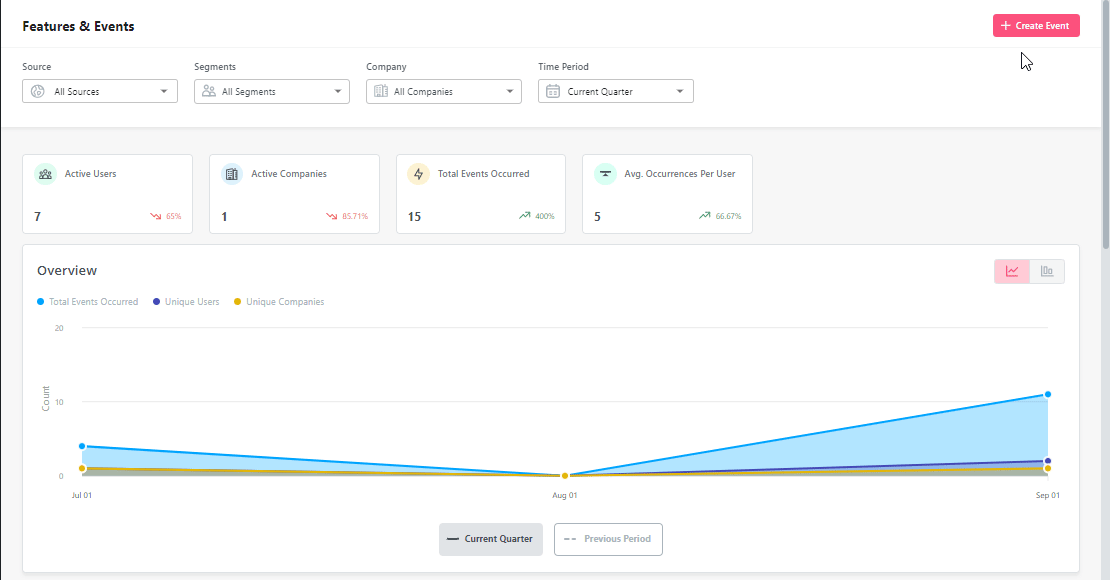
- Trends and funnels: Userpilot’s trends and funnels report lets you extract actionable insights from big data. You’ll be able to see which stage of an onboarding/conversion funnel most users drop out on and create trend reports with detailed breakdowns by user or time period.

- Saved reports: The saved reports analytics dashboard shows you all the reports you’ve created and lets you filter, export, or delete any reports in a single click. In addition to adding filters or sorting by report type, you can also edit or duplicate reports to help you review analytics.

- Analytics integrations: Userpilot integrates with some of the most popular analytics tools like Amplitude, Mixpanel, Segment, Google Analytics, and more. This makes it possible to sync product analytics both ways between the tools in your tech stack (two-way integration is only available for Hubspot at the time of writing, more to come).
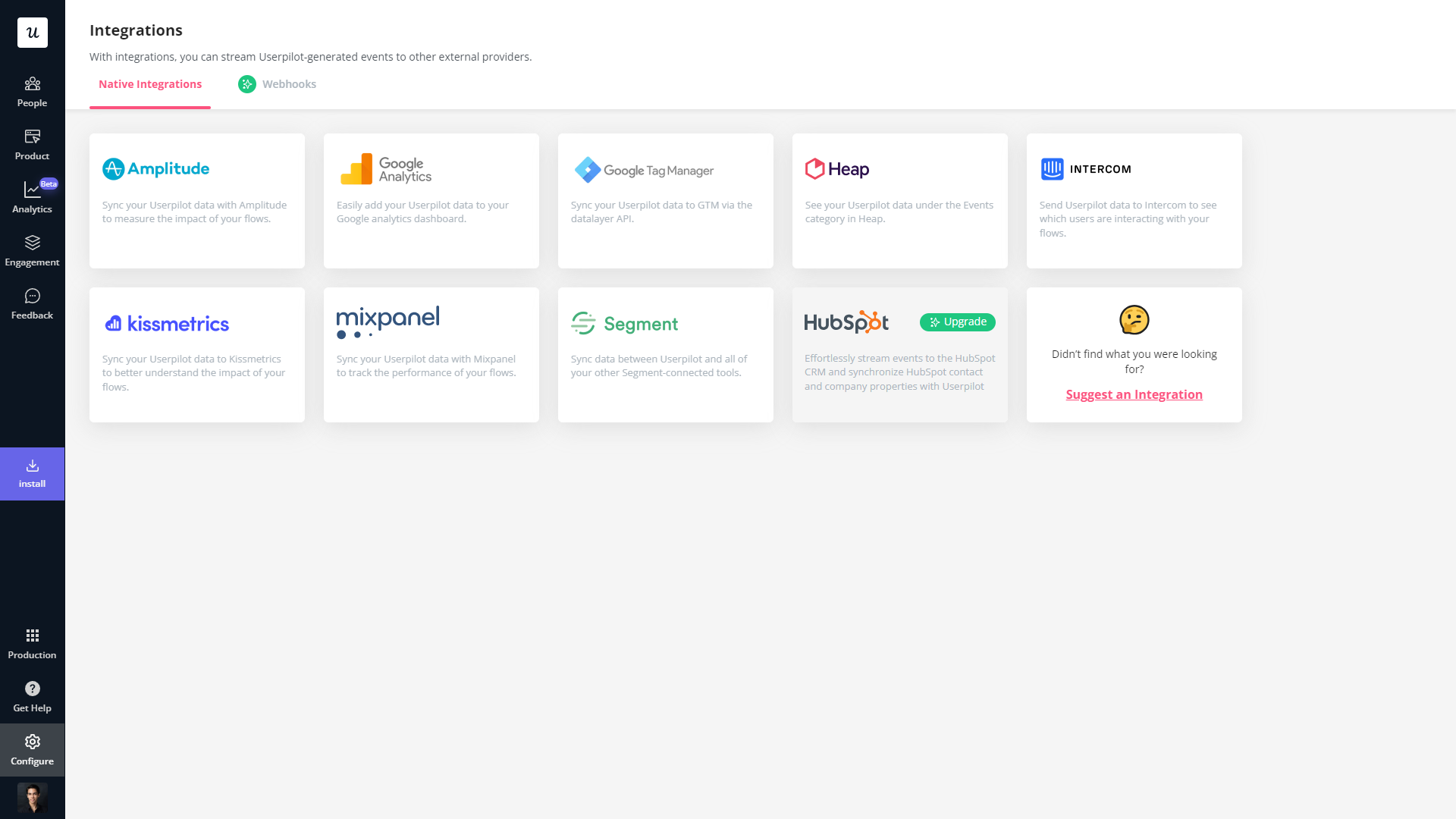
Userpilot’s main use case: user feedback
User feedback is an essential part of listening to the Voice of the Customer (VoC) and making product development or marketing decisions that best suit your customer base. Userpilot has a no-code survey builder, 14 templates to choose from, and advanced analytics for extracting insights.
Here are the Userpilot features you can use to collect customer feedback and analyze it:
- Survey builder: Userpilot’s survey builder lets you edit the content, update the widget’s style/placement, and set page-specific or event-specific triggers to ensure that users see the survey at the most contextual moment — all without writing a single line of code. You can also translate surveys into your audience’s native language.

- Survey templates: There are 14 survey templates to choose from with a wide array of different use cases. You can collect qualitative responses on how to improve the user/product experience or quantitative data for customer satisfaction benchmarking such as CSAT and CES scores.
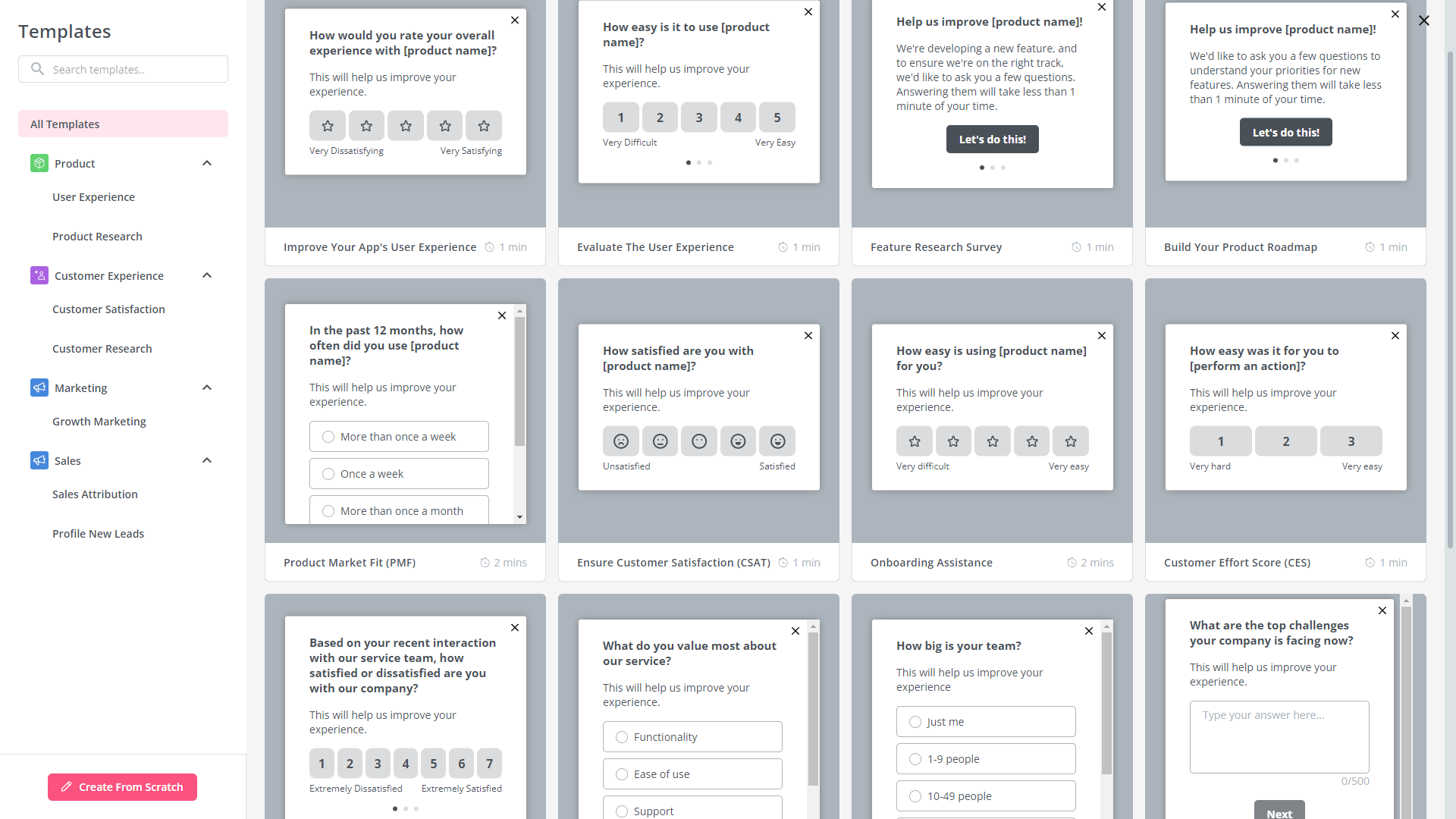
- Advanced analytics: Userpilot’s advanced survey analytics will show you what the most common responses were, what percentage of users selected a specific option, and display open-ended feedback about your product or specific features.
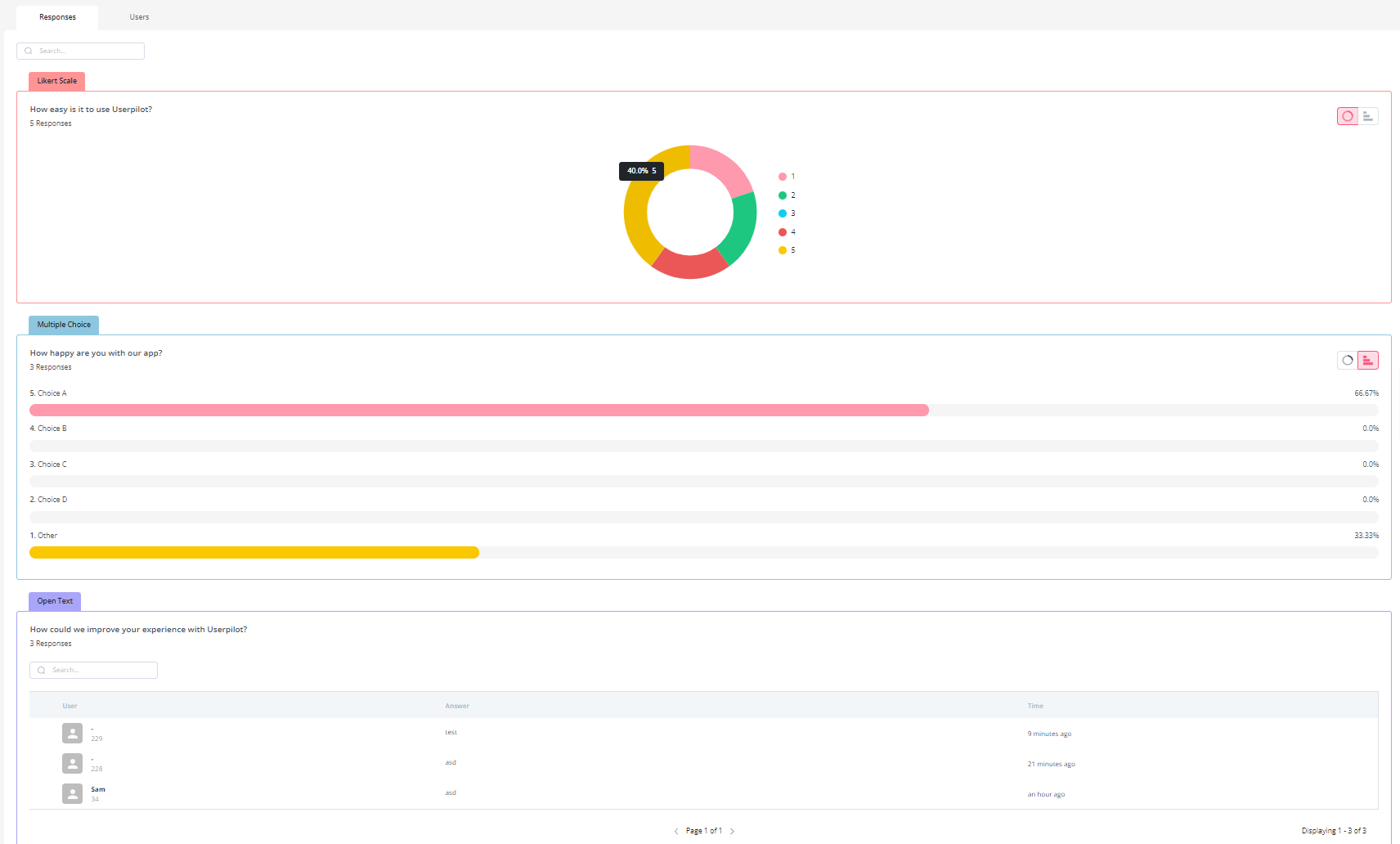
- NPS dashboard: Userpilot’s NPS dashboard compiles response data from all NPS surveys so you don’t have to manually go into each survey and check its analytics. You’ll be able to view key metrics like response rates, total views, and NPS history and sort all the data by different segments.

How much does Userpilot cost?
Userpilot’s transparent pricing ranges from $249/month on the entry-level end to an Enterprise tier for larger companies.
Furthermore, Userpilot’s entry-level plan includes access to all UI patterns and should include everything that most mid-market SaaS businesses need to get started.

Userpilot has three paid plans to choose from:
- Starter: The entry-level Starter plan starts at $249/month and includes features like segmentation, product analytics, reporting, user engagement, user feedback, and customization.
- Growth: The Growth plan starts at $499/month and includes features like resource centers, advanced event-based triggers, unlimited feature tagging, AI-powered content localization, EU hosting options, and a dedicated customer success manager.
- Enterprise: The Enterprise plan uses custom pricing and includes all the features from Starter + Growth plus custom roles/permissions, access to premium integrations, priority support, custom contract, SLA, SAML SSO, activity logs, security audit and compliance (SOC 2/GDPR).
Benefits of using Userpilot
As a full-suite digital adoption platform, Userpilot has all the features you need to onboard users, track analytics, and gather feedback from customers without writing a single line of code. Here are a few pros of using Userpilot as your product growth solution:
- No-code builder: Userpilot’s Chrome extension lets you build flows, add UI elements, and tag features without writing a single line of code.
- UI patterns: There are plenty of UI patterns to choose from when using Userpilot, such as hotspots, tooltips, banners, slideouts, modals, and more!
- Startup-friendly: Userpilot’s entry-level plan gives you access to all available UI patterns so you can hit the ground running.
- Walkthroughs and flows: Build engaging interactive walkthroughs and personalized onboarding flows that target specific segments of your user base.
- Self-service support: Build an in-app resource center to help users solve problems, customize its appearance to align it with your brand, and insert various types of content (videos, flows, or chatbots) to keep your customers satisfied.
- A/B testing: Userpilot’s built-in A/B testing capabilities will help you split-test flows, iterate on the best-performing variants, and continually optimize based on user behavior.
- Feedback collection: Userpilot has built-in NPS surveys with its own unified analytics dashboard and response tagging to help you retarget users. There are other survey types to choose from and you can even create your own custom survey.
- Survey templates: There are 14 survey templates to choose from so you can gather feedback on specific features or run customer satisfaction benchmarking surveys like CSAT and CES.
- Advanced analytics: Userpilot lets you analyze product usage data, monitor engagement on all in-app flows, and use the data to create user segments that are based on behaviors instead of demographics.
- Event tracking: Userpilot’s no-code event tracking lets you tag UI interactions (hovers, clicks, or form fills) and group them into a custom event that reflects feature usage.
- Third-party integrations: Userpilot has built-in integrations with tools like Amplitude, Mixpanel, Kissmetrics, Segment, Heap, HubSpot, Intercom, Google Analytics, and Google Tag Manager so you can share data between all the solutions in your tech stack.
Drawbacks of using Userpilot
Of course, no tool is perfect and there are a few cons to consider before choosing Userpilot as your user onboarding or product growth solution:
- Employee onboarding: Currently, Userpilot only supports in-app customer onboarding.
- Mobile apps: Userpilot doesn’t have any mobile compatibility which could make it difficult for developers with cross-platform applications to create a consistent user experience for both versions of their product.
- Freemium plan: There’s no freemium Userpilot plan so those bootstrapping their startup and need sub-$100 solutions should consider more affordable onboarding platforms like UserGuiding or Product Fruits.
Conclusion
While Userlane offers impressive functionality, there are a few drawbacks that need to be considered before making the final decision. If you’re looking for an alternative solution with superior functionality and greater value for money, then Userpilot is what you need. Book a demo to see it in action.
![]()
Looking for the best product growth tool? Userpilot is what you need!


